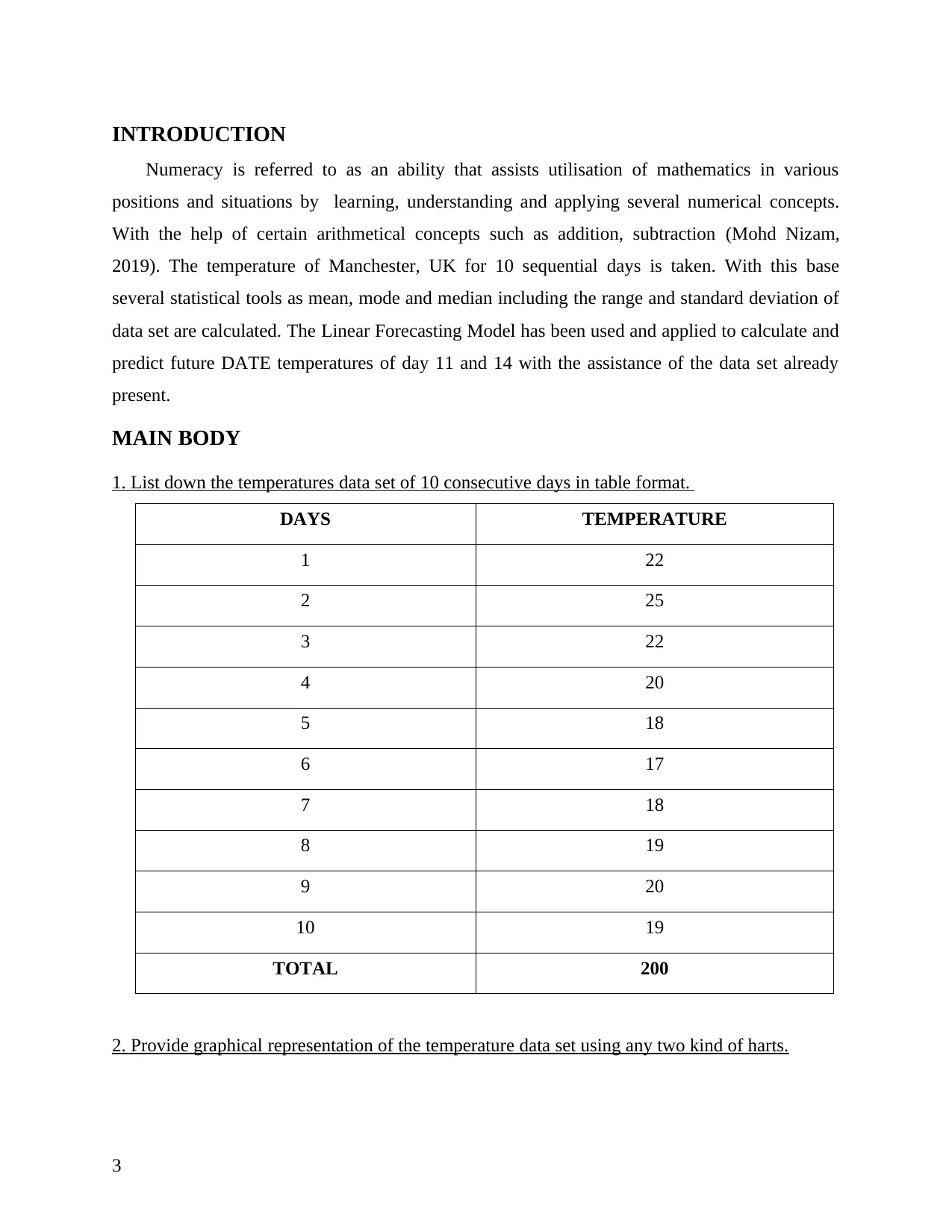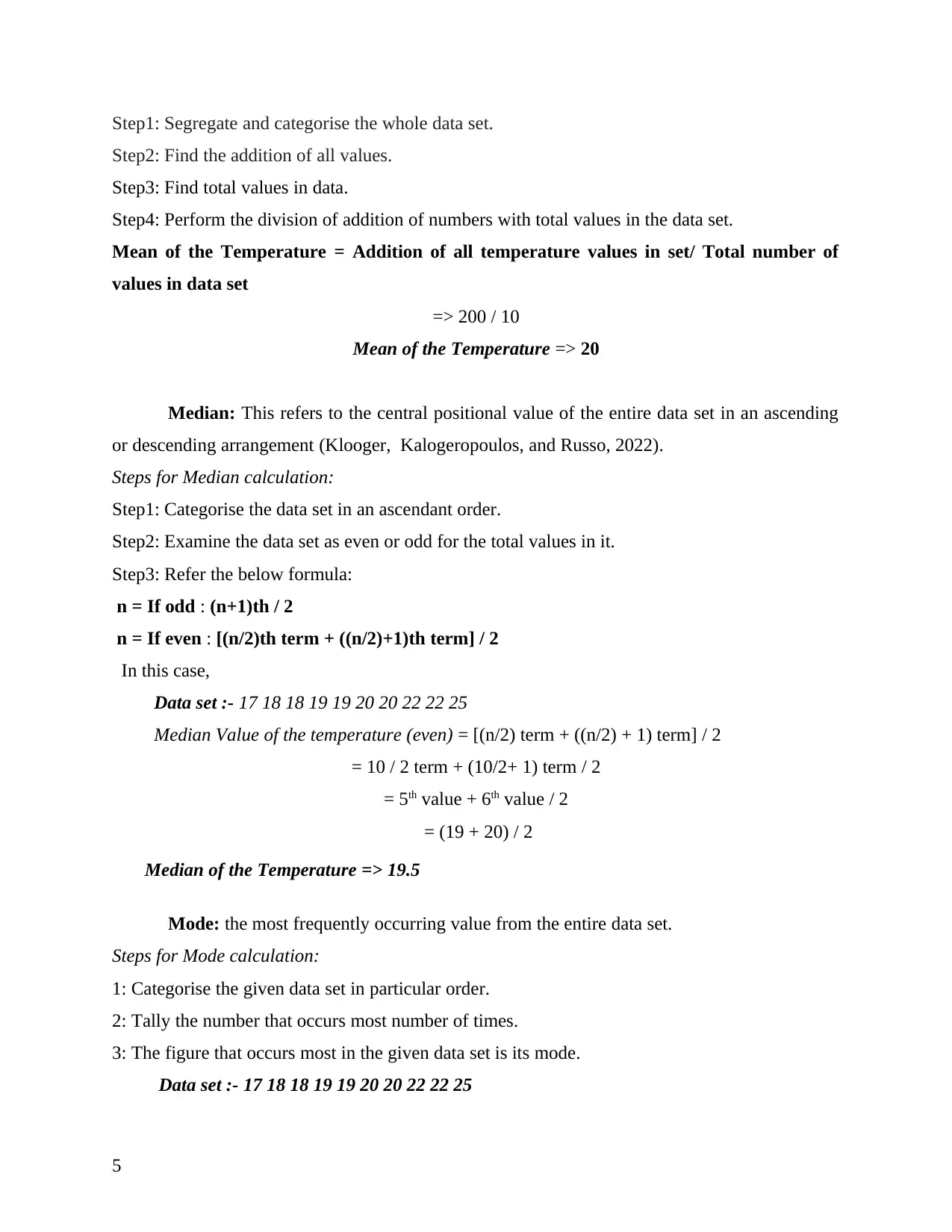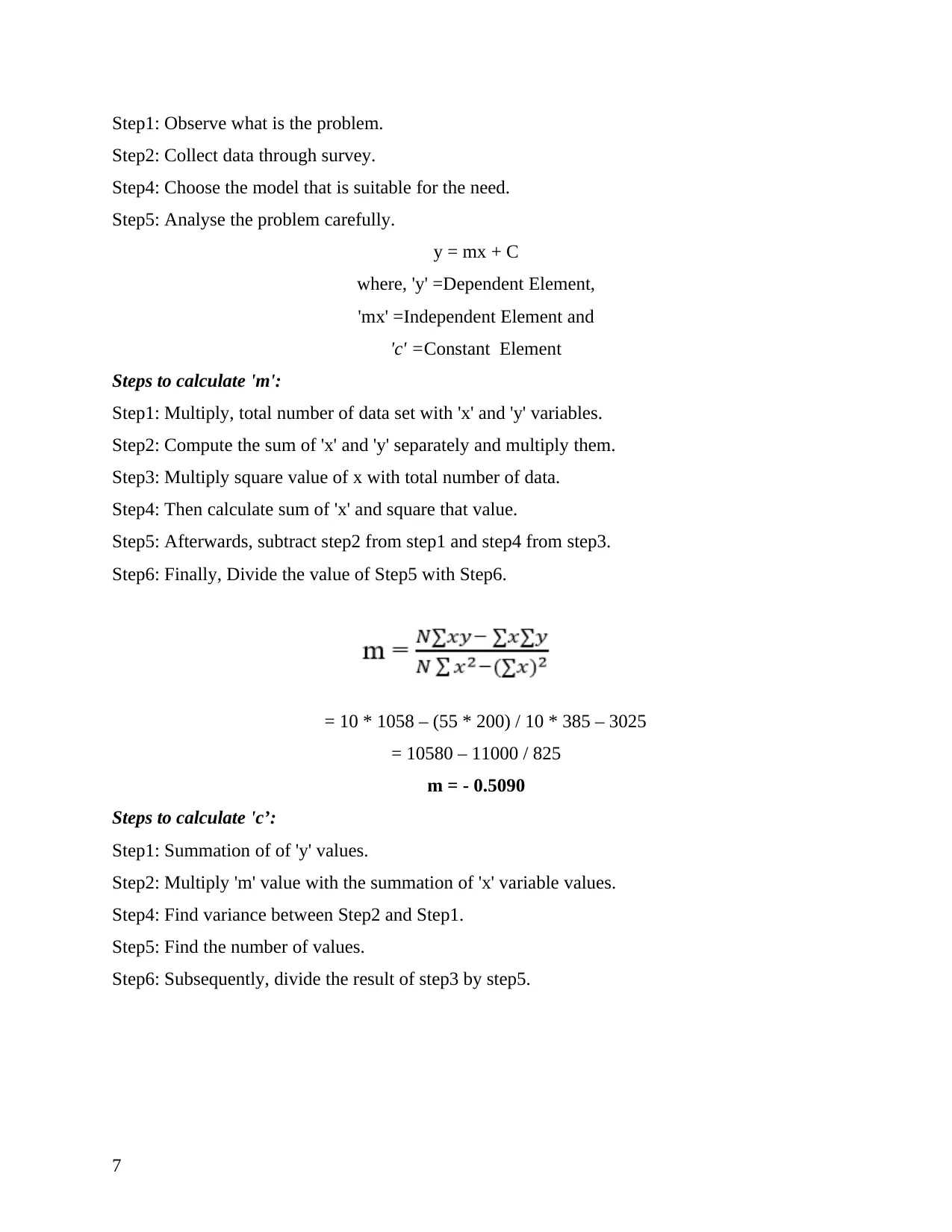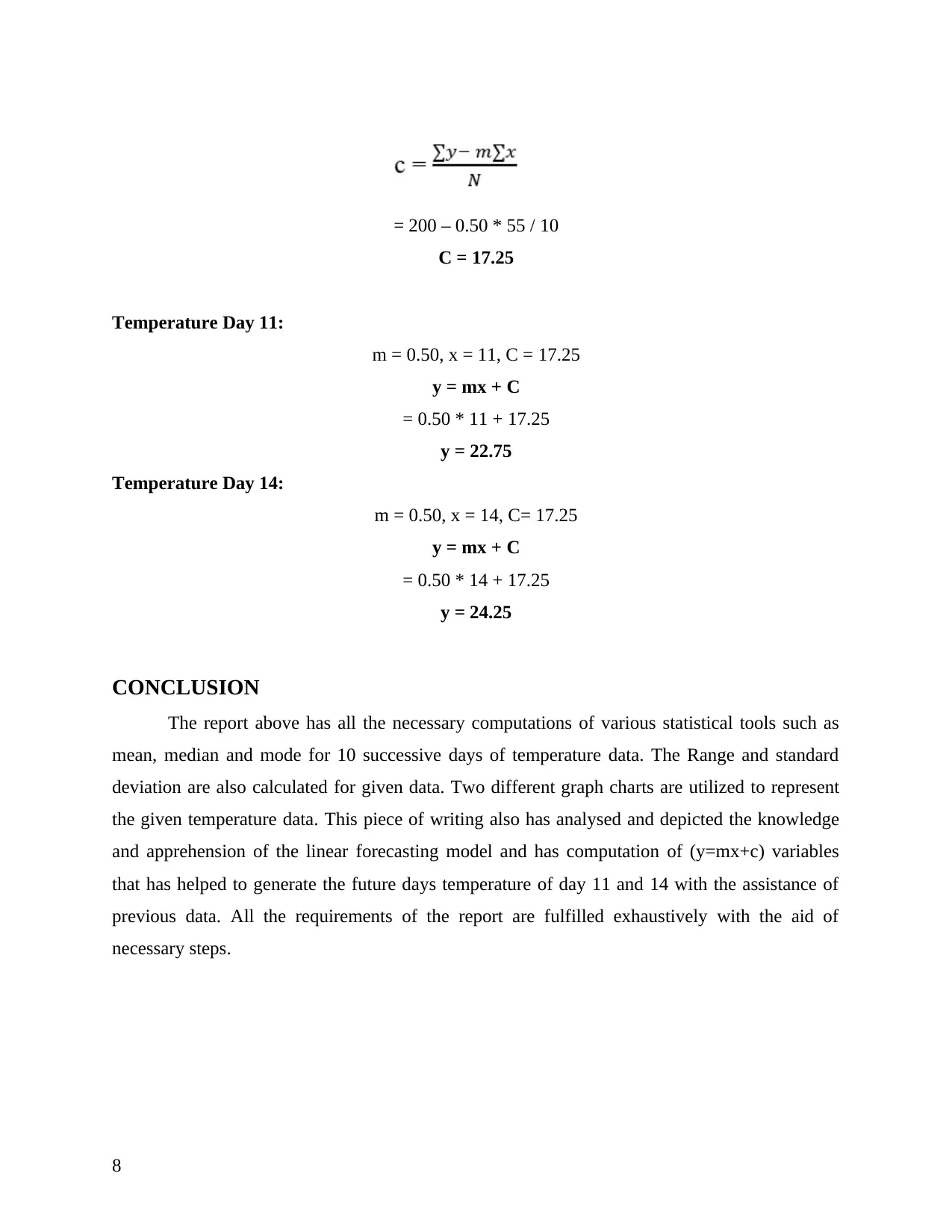Numeracy and Data Analysis: Computation of Statistical Tools and Linear Forecasting Model
VerifiedAdded on 2023/06/09
|9
|1673
|293
AI Summary
This report discusses the computation of statistical tools such as mean, median, mode, range, and standard deviation for temperature data and the use of the linear forecasting model to predict future temperatures. It also includes graphical representation of the temperature data set and the necessary steps for computation. The report fulfills all the requirements exhaustively with the aid of necessary steps.
Contribute Materials
Your contribution can guide someone’s learning journey. Share your
documents today.

Numeracy and Data
Analysis
Analysis
Secure Best Marks with AI Grader
Need help grading? Try our AI Grader for instant feedback on your assignments.

Table of Contents
INTRODUCTION...........................................................................................................................3
MAIN BODY ..................................................................................................................................3
1. List down the temperatures data set of 10 consecutive days in table format. .........................3
2. Provide graphical representation of the temperature data set using any two kind of harts.....3
3. Figure out the values of mean, median, mode, range and standard deviation for temperature
data with the help of steps needed for computation.....................................................................4
4. Calculate the values of 'm' and 'c' and exhibit the use of steps needed. By taking the values
of 'm' and 'c', anticipate temperature for day 11 and 14. .............................................................6
CONCLUSION................................................................................................................................8
REFERENCES................................................................................................................................9
INTRODUCTION...........................................................................................................................3
MAIN BODY ..................................................................................................................................3
1. List down the temperatures data set of 10 consecutive days in table format. .........................3
2. Provide graphical representation of the temperature data set using any two kind of harts.....3
3. Figure out the values of mean, median, mode, range and standard deviation for temperature
data with the help of steps needed for computation.....................................................................4
4. Calculate the values of 'm' and 'c' and exhibit the use of steps needed. By taking the values
of 'm' and 'c', anticipate temperature for day 11 and 14. .............................................................6
CONCLUSION................................................................................................................................8
REFERENCES................................................................................................................................9

INTRODUCTION
Numeracy is referred to as an ability that assists utilisation of mathematics in various
positions and situations by learning, understanding and applying several numerical concepts.
With the help of certain arithmetical concepts such as addition, subtraction (Mohd Nizam,
2019). The temperature of Manchester, UK for 10 sequential days is taken. With this base
several statistical tools as mean, mode and median including the range and standard deviation of
data set are calculated. The Linear Forecasting Model has been used and applied to calculate and
predict future DATE temperatures of day 11 and 14 with the assistance of the data set already
present.
MAIN BODY
1. List down the temperatures data set of 10 consecutive days in table format.
DAYS TEMPERATURE
1 22
2 25
3 22
4 20
5 18
6 17
7 18
8 19
9 20
10 19
TOTAL 200
2. Provide graphical representation of the temperature data set using any two kind of harts.
3
Numeracy is referred to as an ability that assists utilisation of mathematics in various
positions and situations by learning, understanding and applying several numerical concepts.
With the help of certain arithmetical concepts such as addition, subtraction (Mohd Nizam,
2019). The temperature of Manchester, UK for 10 sequential days is taken. With this base
several statistical tools as mean, mode and median including the range and standard deviation of
data set are calculated. The Linear Forecasting Model has been used and applied to calculate and
predict future DATE temperatures of day 11 and 14 with the assistance of the data set already
present.
MAIN BODY
1. List down the temperatures data set of 10 consecutive days in table format.
DAYS TEMPERATURE
1 22
2 25
3 22
4 20
5 18
6 17
7 18
8 19
9 20
10 19
TOTAL 200
2. Provide graphical representation of the temperature data set using any two kind of harts.
3

3. Figure out the values of mean, median, mode, range and standard deviation for temperature
data with the help of steps needed for computation.
Mean: It refers to the average of the entire data set present.
Steps for Mean calculation:
4
31/12/1899
01/01/1900
02/01/1900
03/01/1900
04/01/1900
05/01/1900
06/01/1900
07/01/1900
08/01/1900
09/01/1900
0
5
10
15
20
25
30
emperature yT ( )
0
5
10
15
20
25
30
emperature yT ( )
data with the help of steps needed for computation.
Mean: It refers to the average of the entire data set present.
Steps for Mean calculation:
4
31/12/1899
01/01/1900
02/01/1900
03/01/1900
04/01/1900
05/01/1900
06/01/1900
07/01/1900
08/01/1900
09/01/1900
0
5
10
15
20
25
30
emperature yT ( )
0
5
10
15
20
25
30
emperature yT ( )
Secure Best Marks with AI Grader
Need help grading? Try our AI Grader for instant feedback on your assignments.

Step1: Segregate and categorise the whole data set.
Step2: Find the addition of all values.
Step3: Find total values in data.
Step4: Perform the division of addition of numbers with total values in the data set.
Mean of the Temperature = Addition of all temperature values in set/ Total number of
values in data set
=> 200 / 10
Mean of the Temperature => 20
Median: This refers to the central positional value of the entire data set in an ascending
or descending arrangement (Klooger, Kalogeropoulos, and Russo, 2022).
Steps for Median calculation:
Step1: Categorise the data set in an ascendant order.
Step2: Examine the data set as even or odd for the total values in it.
Step3: Refer the below formula:
n = If odd : (n+1)th / 2
n = If even : [(n/2)th term + ((n/2)+1)th term] / 2
In this case,
Data set :- 17 18 18 19 19 20 20 22 22 25
Median Value of the temperature (even) = [(n/2) term + ((n/2) + 1) term] / 2
= 10 / 2 term + (10/2+ 1) term / 2
= 5th value + 6th value / 2
= (19 + 20) / 2
Median of the Temperature => 19.5
Mode: the most frequently occurring value from the entire data set.
Steps for Mode calculation:
1: Categorise the given data set in particular order.
2: Tally the number that occurs most number of times.
3: The figure that occurs most in the given data set is its mode.
Data set :- 17 18 18 19 19 20 20 22 22 25
5
Step2: Find the addition of all values.
Step3: Find total values in data.
Step4: Perform the division of addition of numbers with total values in the data set.
Mean of the Temperature = Addition of all temperature values in set/ Total number of
values in data set
=> 200 / 10
Mean of the Temperature => 20
Median: This refers to the central positional value of the entire data set in an ascending
or descending arrangement (Klooger, Kalogeropoulos, and Russo, 2022).
Steps for Median calculation:
Step1: Categorise the data set in an ascendant order.
Step2: Examine the data set as even or odd for the total values in it.
Step3: Refer the below formula:
n = If odd : (n+1)th / 2
n = If even : [(n/2)th term + ((n/2)+1)th term] / 2
In this case,
Data set :- 17 18 18 19 19 20 20 22 22 25
Median Value of the temperature (even) = [(n/2) term + ((n/2) + 1) term] / 2
= 10 / 2 term + (10/2+ 1) term / 2
= 5th value + 6th value / 2
= (19 + 20) / 2
Median of the Temperature => 19.5
Mode: the most frequently occurring value from the entire data set.
Steps for Mode calculation:
1: Categorise the given data set in particular order.
2: Tally the number that occurs most number of times.
3: The figure that occurs most in the given data set is its mode.
Data set :- 17 18 18 19 19 20 20 22 22 25
5

Mode of the Temperature=> 18, 19, 20, 22
Range: It is the difference between the maximum value of the data set and the minimum
value (Austria, and Caringa, 2019).
Steps for Range calculation:
1: Analyse the data.
2: Pick the minimum and maximum value.
3: Find difference between those two numbers.
Computation of Temperature Range
Range of data set = ( Maximum value – Minimum Value )
= (25 - 17)
Range of Temperature => 8
Standard Deviation: It is a statistical tool used to measure and analyse the dispersion of
each value of the data set from the average value of the entire data (Tully, and Gunn, 2019).
Steps for calculation of standard deviation:
1: Assume or calculate the mean value.
2: Find deviation of each value from average.
3: Square the value and take the addition.
4: Divide total of square value from total number of values given.
5: Take square root of the resultant numbers.
Calculation of standard deviation of Temperature:
Standard Deviation = √∑ (xi – μ) ^ 2 / N
=√ (200 – 20) ^ 2 / 10
Standard Deviation for the Temperature = 56.92
4. Calculate the values of 'm' and 'c' and exhibit the use of steps needed. By taking the values of
'm' and 'c', anticipate temperature for day 11 and 14.
Linear Forecasting Model: The main aim of the use of this statistical tool is to analyse,
anticipate and calculate future day values with the help of already existing values. (Andika, and
et.al., 2021)
Steps for Linear Forecasting theory:
6
Range: It is the difference between the maximum value of the data set and the minimum
value (Austria, and Caringa, 2019).
Steps for Range calculation:
1: Analyse the data.
2: Pick the minimum and maximum value.
3: Find difference between those two numbers.
Computation of Temperature Range
Range of data set = ( Maximum value – Minimum Value )
= (25 - 17)
Range of Temperature => 8
Standard Deviation: It is a statistical tool used to measure and analyse the dispersion of
each value of the data set from the average value of the entire data (Tully, and Gunn, 2019).
Steps for calculation of standard deviation:
1: Assume or calculate the mean value.
2: Find deviation of each value from average.
3: Square the value and take the addition.
4: Divide total of square value from total number of values given.
5: Take square root of the resultant numbers.
Calculation of standard deviation of Temperature:
Standard Deviation = √∑ (xi – μ) ^ 2 / N
=√ (200 – 20) ^ 2 / 10
Standard Deviation for the Temperature = 56.92
4. Calculate the values of 'm' and 'c' and exhibit the use of steps needed. By taking the values of
'm' and 'c', anticipate temperature for day 11 and 14.
Linear Forecasting Model: The main aim of the use of this statistical tool is to analyse,
anticipate and calculate future day values with the help of already existing values. (Andika, and
et.al., 2021)
Steps for Linear Forecasting theory:
6

Step1: Observe what is the problem.
Step2: Collect data through survey.
Step4: Choose the model that is suitable for the need.
Step5: Analyse the problem carefully.
y = mx + C
where, 'y' =Dependent Element,
'mx' =Independent Element and
'c' =Constant Element
Steps to calculate 'm':
Step1: Multiply, total number of data set with 'x' and 'y' variables.
Step2: Compute the sum of 'x' and 'y' separately and multiply them.
Step3: Multiply square value of x with total number of data.
Step4: Then calculate sum of 'x' and square that value.
Step5: Afterwards, subtract step2 from step1 and step4 from step3.
Step6: Finally, Divide the value of Step5 with Step6.
= 10 * 1058 – (55 * 200) / 10 * 385 – 3025
= 10580 – 11000 / 825
m = - 0.5090
Steps to calculate 'c’:
Step1: Summation of of 'y' values.
Step2: Multiply 'm' value with the summation of 'x' variable values.
Step4: Find variance between Step2 and Step1.
Step5: Find the number of values.
Step6: Subsequently, divide the result of step3 by step5.
7
Step2: Collect data through survey.
Step4: Choose the model that is suitable for the need.
Step5: Analyse the problem carefully.
y = mx + C
where, 'y' =Dependent Element,
'mx' =Independent Element and
'c' =Constant Element
Steps to calculate 'm':
Step1: Multiply, total number of data set with 'x' and 'y' variables.
Step2: Compute the sum of 'x' and 'y' separately and multiply them.
Step3: Multiply square value of x with total number of data.
Step4: Then calculate sum of 'x' and square that value.
Step5: Afterwards, subtract step2 from step1 and step4 from step3.
Step6: Finally, Divide the value of Step5 with Step6.
= 10 * 1058 – (55 * 200) / 10 * 385 – 3025
= 10580 – 11000 / 825
m = - 0.5090
Steps to calculate 'c’:
Step1: Summation of of 'y' values.
Step2: Multiply 'm' value with the summation of 'x' variable values.
Step4: Find variance between Step2 and Step1.
Step5: Find the number of values.
Step6: Subsequently, divide the result of step3 by step5.
7
Paraphrase This Document
Need a fresh take? Get an instant paraphrase of this document with our AI Paraphraser

= 200 – 0.50 * 55 / 10
C = 17.25
Temperature Day 11:
m = 0.50, x = 11, C = 17.25
y = mx + C
= 0.50 * 11 + 17.25
y = 22.75
Temperature Day 14:
m = 0.50, x = 14, C= 17.25
y = mx + C
= 0.50 * 14 + 17.25
y = 24.25
CONCLUSION
The report above has all the necessary computations of various statistical tools such as
mean, median and mode for 10 successive days of temperature data. The Range and standard
deviation are also calculated for given data. Two different graph charts are utilized to represent
the given temperature data. This piece of writing also has analysed and depicted the knowledge
and apprehension of the linear forecasting model and has computation of (y=mx+c) variables
that has helped to generate the future days temperature of day 11 and 14 with the assistance of
previous data. All the requirements of the report are fulfilled exhaustively with the aid of
necessary steps.
8
C = 17.25
Temperature Day 11:
m = 0.50, x = 11, C = 17.25
y = mx + C
= 0.50 * 11 + 17.25
y = 22.75
Temperature Day 14:
m = 0.50, x = 14, C= 17.25
y = mx + C
= 0.50 * 14 + 17.25
y = 24.25
CONCLUSION
The report above has all the necessary computations of various statistical tools such as
mean, median and mode for 10 successive days of temperature data. The Range and standard
deviation are also calculated for given data. Two different graph charts are utilized to represent
the given temperature data. This piece of writing also has analysed and depicted the knowledge
and apprehension of the linear forecasting model and has computation of (y=mx+c) variables
that has helped to generate the future days temperature of day 11 and 14 with the assistance of
previous data. All the requirements of the report are fulfilled exhaustively with the aid of
necessary steps.
8

REFERENCES
Books and Journals
Andika, W.D., and et.al., 2021. Playing board games with mathematical self-concept to support
early numeracy skill of 5-6 years old children (Peer Review).
Austria, M. and Caringa, I.M., 2019. Numeracy Tool with E-Games: An Intervention in
Enhancing Mathematics Instruction. Ascendens Asia Journal of Multidisciplinary
Research Abstracts, 3(2N).
Klooger, M., Kalogeropoulos, P. and Russo, J., 2022. GRIN (Getting Ready in Numeracy):
Confidence comes from being prepared. Prime Number, 37(1), pp.20-23.
Mohd Nizam, D., 2019. Digital educational games on numeracy for 5-year-olds: application of
eye tracking methodology (Doctoral dissertation, University of Leicester).
Tully, C. and Gunn, E., 2019. Practical matters: Living in a material world: Beyond numeracy
anxiety. Fine Print, 42(2), pp.17-19.
9
Books and Journals
Andika, W.D., and et.al., 2021. Playing board games with mathematical self-concept to support
early numeracy skill of 5-6 years old children (Peer Review).
Austria, M. and Caringa, I.M., 2019. Numeracy Tool with E-Games: An Intervention in
Enhancing Mathematics Instruction. Ascendens Asia Journal of Multidisciplinary
Research Abstracts, 3(2N).
Klooger, M., Kalogeropoulos, P. and Russo, J., 2022. GRIN (Getting Ready in Numeracy):
Confidence comes from being prepared. Prime Number, 37(1), pp.20-23.
Mohd Nizam, D., 2019. Digital educational games on numeracy for 5-year-olds: application of
eye tracking methodology (Doctoral dissertation, University of Leicester).
Tully, C. and Gunn, E., 2019. Practical matters: Living in a material world: Beyond numeracy
anxiety. Fine Print, 42(2), pp.17-19.
9
1 out of 9
Related Documents
Your All-in-One AI-Powered Toolkit for Academic Success.
+13062052269
info@desklib.com
Available 24*7 on WhatsApp / Email
![[object Object]](/_next/static/media/star-bottom.7253800d.svg)
Unlock your academic potential
© 2024 | Zucol Services PVT LTD | All rights reserved.

